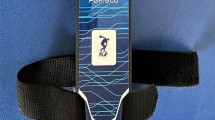Summary
We reviewed 45 patients on average 14.7 years after surgery for rupture of the anterior cruciate ligament. The aim of the study was to compare the reliability of the Lachman test to evaluation of knee laxity with the KT 1000 arthrometer and the ultrasound-assisted Lachman test. Forty-five knees were examined with the Lachman test: 12 knees showed no sign of instability; 20 had a + positive Lachman test with a hard end point; 6 with a + positive test had no end point and were rated as unstable; a ++ Lachman test was found in 7 knees. With the KT 1000 Arthrometer 44 knees were examined: 30 knees were graded as stable according to the criteria of Daniel; 14 knees were unstable. We used the ultrasound-guided Lachman test in 44 knees. Taking only the side-to-side difference into account, 37 knees were stable and 7 unstable. According to Gruber, a single translation greater than 4 mm is also a sign of instability. Therefore, 12 knees were unstable, although 6 of these knees were rated as stable, taking the side-to-side difference into account. Comparing the two instrument measurements, all knees with ultrasound-rated instability on the basis of side-to-side measurements were also rated as unstable with the KT 1000 arthrometer. Only half of the knees rated as unstable because of a single translation greater than 4 mm with the ultrasound technique were rated as unstable with the KT 1000 arthrometer. Our results show that the accuracy of the Lachman test is as good as the instrument evaluation if the end point is taken into consideration. A positive Lachman test indicating anterior knee laxity is one where the soft end point is as described by Torg et al. Both instrument measurements are accurate in indicating anterior knee laxity, but only if they are used by an experienced examiner. Using the side-to-side measurements, the sensitivity of the KT 1000 arthrometer is higher. If only single translations greater than 4 mm without a significant side-to-side difference with the ultrasound technique are interpreted as anterior knee instability, then some knees will be rated as unstable, although both the clinical and KT 1000 arthrometer examinations prove them to be stable. We believe that only a side-to-side difference with the instrument technique should be interpreted as knee laxity. Borderline positive measurements should only be used together with the clinical findings. Both instrument measurements can help to improve the quality of the clinical examination if the examiners are inexperienced. If instrument measurements are required, we believe that the ultrasound technique is easy and cheap to perform. Nevertheless, we believe that instrument measurements of anterior knee laxity are not necessary if a thorough clinical examination is performed, taking the end point of the Lachman test into consideration.
Zusammenfassung
45 Patienten wurden durchschnittlich 14,7 Jahre nach operativer Versorgung einer vorderen Kreuzbandruptur untersucht. Der Lachman-Test mit Anschlagphänomen ermöglicht eine hohe Genauigkeit in der Erfassung von vorderen Knieinstabilitäten. Ohne Berücksichtigung des Anschlagphänomens ist der Lachman-Test nicht ausreichend sensitiv. Beide apparative Methoden bestätigten die bei der klinischen Untersuchung gefundenen Instabilitäten. Bei beiden apparativen Methoden sollte nur die seitenvergleichende Messung eingesetzt werden. Einseitig erhobene Befunde lassen sich im Vergleich aller 3 Methoden nicht bestätigen und sollten nicht als positiv im Sinne einer Instabilität verwendet werden.
Similar content being viewed by others
Author information
Authors and Affiliations
Rights and permissions
About this article
Cite this article
König, D., Rütt, J., Kumm, D. et al. Clinical diagnosis and instrumented measurement of anterior knee laxity. A comparative study of the Lachman test, KT 1000 knee ligament arthrometer and the sonographic Lachman test. Unfallchirurg 101, 209–213 (1998). https://doi.org/10.1007/s001130050256
Published:
Issue Date:
DOI: https://doi.org/10.1007/s001130050256




